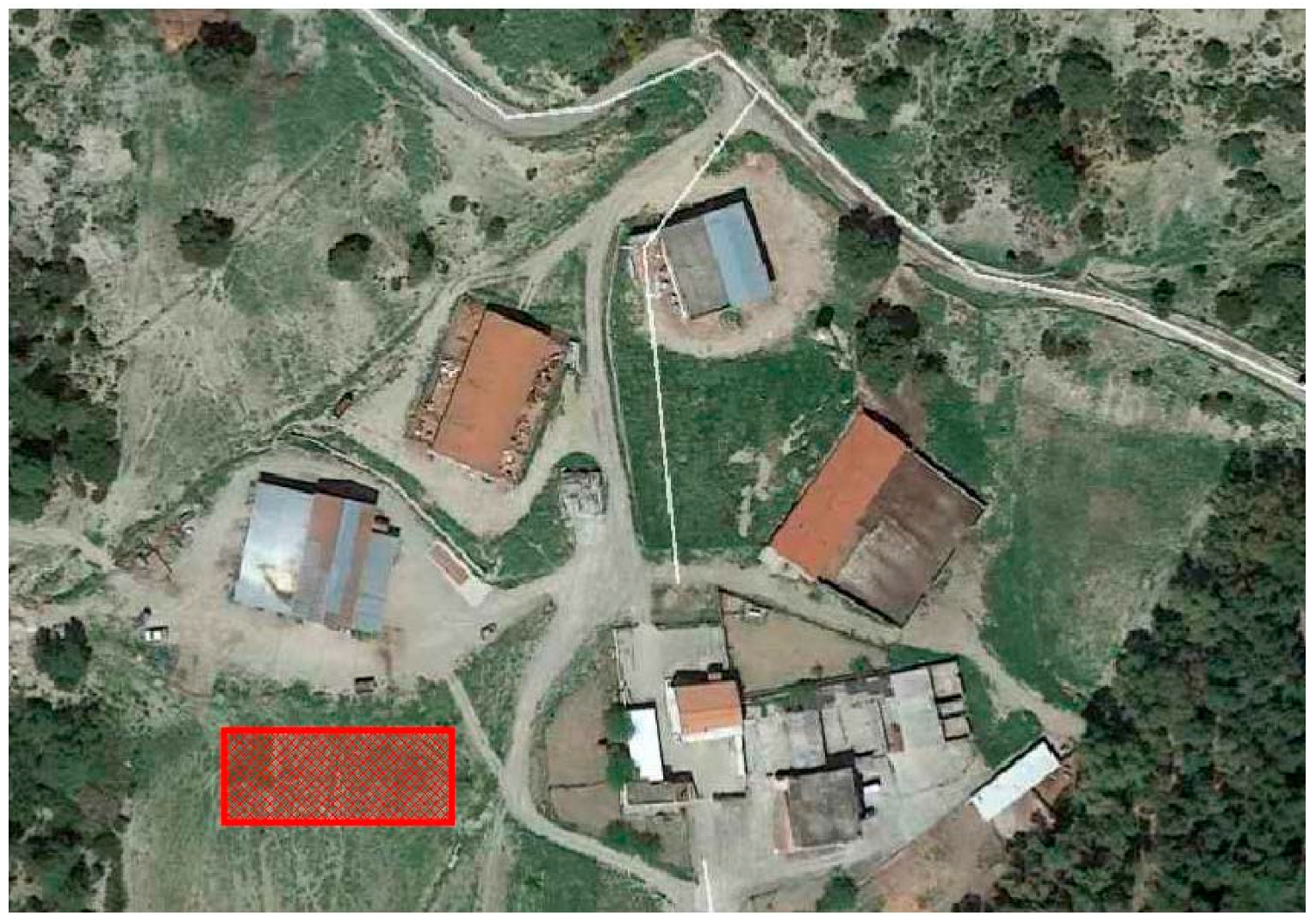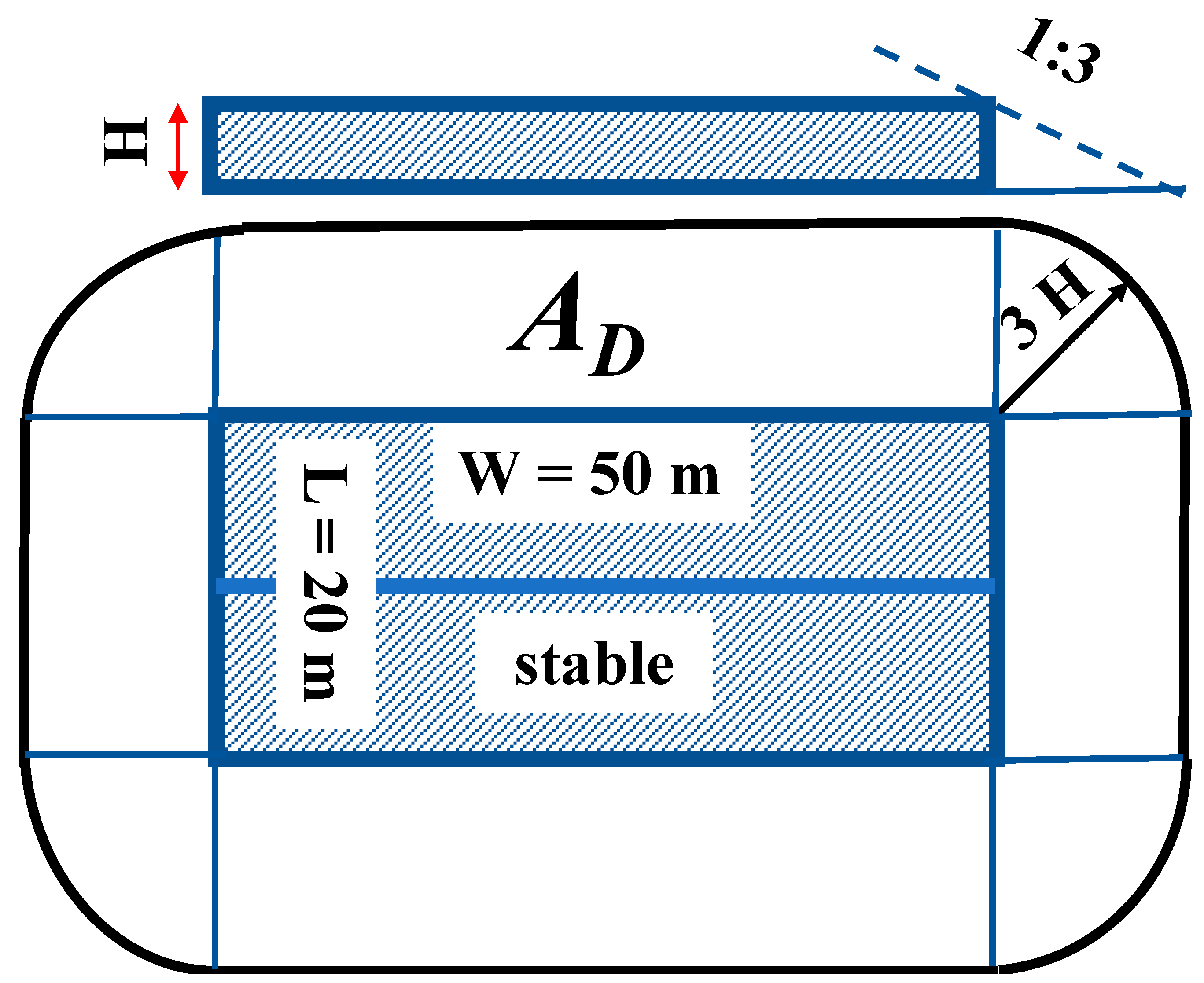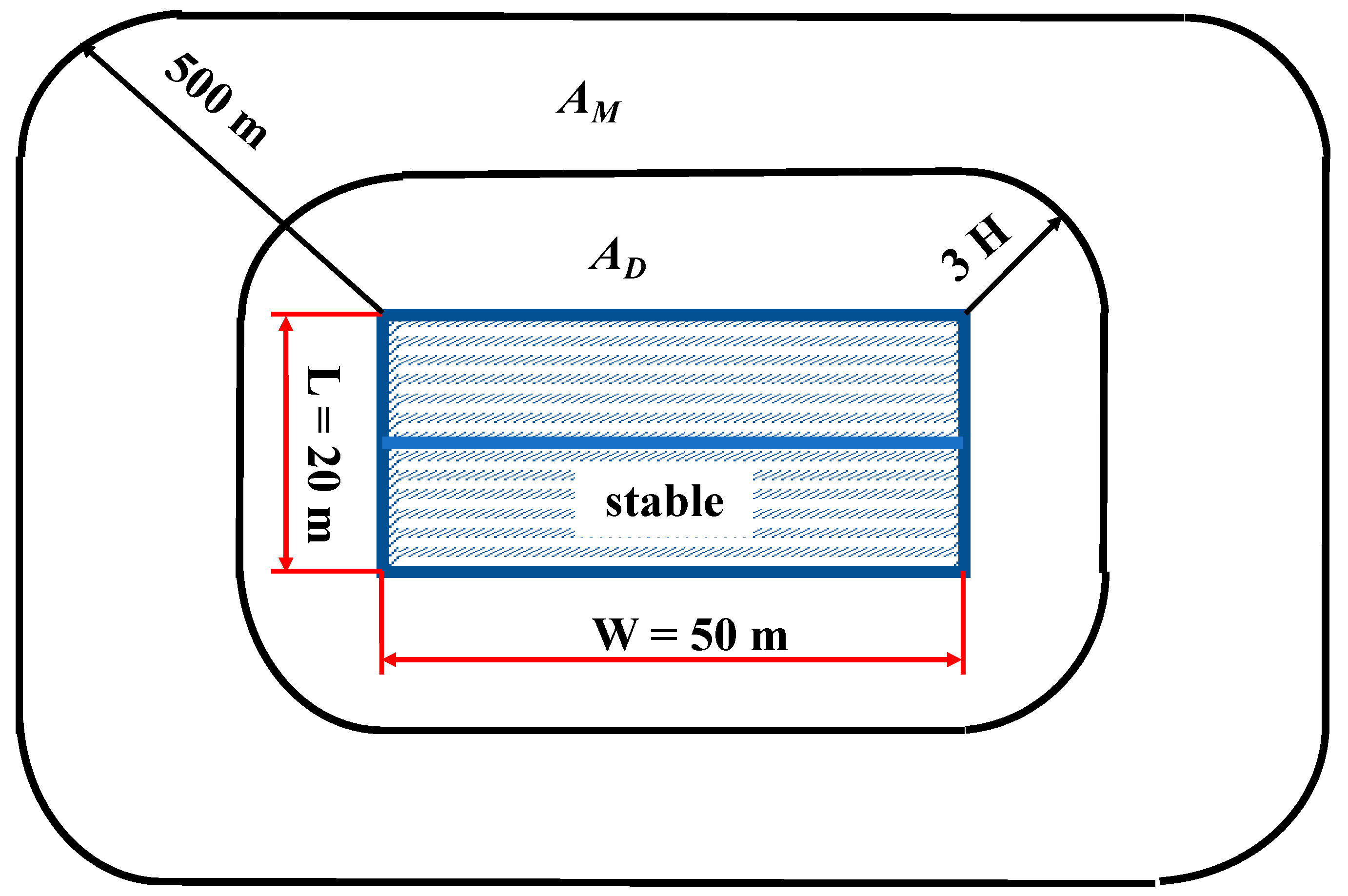Lightning Protection Systems Suitable for Stables: A Case Study
Abstract
1. Introduction
2. Materials and Methods
2.1. The Stable
- Reinforced concrete for foundations, floors, walls and grating in the pit;
- Laminated wood and solid wood for the frame of the walls, decks and the roof frame;
- Wooden boards for wall cladding;
- Glued laminated wood for the roof beams;
- Roof cover with insulated metal roof;
- Partition walls in light brick, plastered;
- Floors and walls of the milk room and toilettes with tiles or synthetic resin;
- Doors and windows in galvanized metal and wood;
- Electrical, sanitary, and lightning protection systems.
2.2. The LPS
3. Results and Discussion
- Nx is the number of lightning strokes per year on the surface to be evaluated;
- Px is the probability of damage;
- Lx is the loss, or the quantitative assessment of damages.
- .
- ,
4. Conclusions
Author Contributions
Funding
Conflicts of Interest
References
- Mona, T.; Horváth, À.; Ács, F. A thunderstorm cell-lightning activity analysis: The new concept of air mass catchment. Atmos. Res. 2016, 169, 340–344. [Google Scholar] [CrossRef]
- Barthe, C.; Deierling, W.; Barth, M.C. Estimation of total lightning from various storm parameters: A cloud-resolving model study. J. Geophys. Res. Atmos. 2010, 115. [Google Scholar] [CrossRef]
- Wapler, K.; James, P. Thunderstorm occurrence and characteristics in Central Europe under different synoptic conditions. Atmos. Res. 2015, 158–159, 231–244. [Google Scholar] [CrossRef]
- Meyer, V.K.; Höller, H.; Betz, H.D. The temporal evolution of three-dimensional lightning parameters and their suitability for thunderstorm tracking and nowcasting. Atmos. Chem. Phys. 2013, 13, 5151–5161. [Google Scholar] [CrossRef]
- Smith, S.B.; LaDue, J.G.; MacGorman, D.R. The relationship between cloud-to-ground lightning polarity and surface equivalent potential temperature during three tornadic outbreaks. Mon. Weather Rev. 2000, 128, 3320–3328. [Google Scholar] [CrossRef]
- Carey, L.D.; Buffalo, K.M. Environmental control of cloud-to-ground lightning polarity in severe storms. Mon. Weather Rev. 2007, 135, 1327–1353. [Google Scholar] [CrossRef]
- Csirmaz, K.; Simon, A.; Pistotnik, G.; Polyánszky, Z.; Neštiak, M.; Nagykovácsi, Z.; Sokol, A. A study of rotation in thunderstorms in a weakly- ormoderately-sheared environment. Atmos. Res. 2013, 123, 93–116. [Google Scholar] [CrossRef]
- Pascuzzi, S.; Santoro, F. Exposure of farm workers to electromagnetic radiation from cellular network radio base stations situated on rural agricultural land. Int. J. Occup. Saf. Ergon. 2015, 21, 351–358. [Google Scholar] [CrossRef]
- Pascuzzi, S.; Santoro, F. Evaluation of farmers’ OSH hazard in operation nearby mobile telephone radio base stations. In Proceedings of the 16th International Scientific Conference Engineering for Rural Development, Jelgava, Latvia, 24–26 May 2017; Volume 16, pp. 748–755, ISSN 1691-5976. [Google Scholar]
- Deierling, W.; Petersen, W.A. Total lightning activity as an indicator of updraft characteristics. J. Geophys. Res. Atmos. 2008, 113, 16. [Google Scholar] [CrossRef]
- Sánchez, J.L.; López, L.; Garca-Ortega, E.; Gil, B. Nowcasting of kinetic energy of hail precipitation using radar. Atmos. Res. 2013, 123, 48–60. [Google Scholar] [CrossRef]
- Anderson, R.B.; Eriksson, A.J. Lightning parameters for engineering applications. Electra 1980, 69, 65–102. [Google Scholar]
- Armstrong, H.; Whitehead, E. Field and Analytical Studies of Transmission Line Shielding. IEEE Trans. Power Appar. Syst. 1968, PAS-87, 270–281. [Google Scholar] [CrossRef]
- Berger, K.; Anderson, R.B.; Kroninger, H. Parameters of lightning flashes. Electra 1975, 41, 23–37. [Google Scholar]
- Berger, K.; Garbagnati, E. Lightning current parameters. Results obtained in Switzerland and in Italy. In Proceedings of the URSI Conference, Florence, Italy, 28 August–5 September 1984; pp. 1–11. [Google Scholar]
- Borghetti, A.; Nucci, C.A.; Paolone, M. Estimation of the statistical distributions of lightning current parameters at ground level from the data recorded by instrumented towers. IEEE Trans. Power Deliv. 2004, 19, 1400–1409. [Google Scholar] [CrossRef]
- Borghetti, A.; Nucci, C.A.; Paolone, M. An Improved Procedure for the Assessment of Overhead Line Indirect Lightning Performance and Its Comparison with the IEEE Std. 1410 Method. IEEE Trans. Power Deliv. 2007, 22, 684–692. [Google Scholar] [CrossRef]
- Borghetti, A.; Nucci, C.A.; Paolone, M. Indirect-Lightning Performance of Overhead Distribution Networks With Complex Topology. IEEE Trans. Power Deliv. 2009, 24, 2206–2213. [Google Scholar] [CrossRef]
- Borghetti, A.; Napolitano, F.; Nucci, C.A.; Tossani, F. Influence of the return stroke current waveform on the lightning performance of distribution lines. IEEE Trans. Power Deliv. 2017, 32, 1800–1808. [Google Scholar] [CrossRef]
- Borghetti, A.; Napolitano, F.; Nucci, C.A.; Tossani, F. Response of distribution networks to direct and indirect lightning: Influence of surge arresters location, flashover occurrence and environmental shielding. Electr. Power Syst. Res. 2017, 153, 73–81. [Google Scholar] [CrossRef]
- Dellera, L.; Garbagnati, E. Lightning stroke simulation by means of the leader progression model—Part I. IEEE Trans. Power Deliv. 1990, 5, 2009–2022. [Google Scholar] [CrossRef]
- Dellera, L.; Garbagnati, E. Lightning stroke simulation by means of the leader progression model—Part II. IEEE Trans. Power Deliv. 1990, 5, 2023–2029. [Google Scholar] [CrossRef]
- Blanco, I.; Sotirios Anifantis, A.; Pascuzzi, S.; Scarascia Mugnozza, G. Hydrogen and renewable energy sources integrated system for greenhouse heating. J. Agric. Eng. 2013, 44, e45. [Google Scholar] [CrossRef]
- Manetto, G.; Cerruto, E.; Pascuzzi, S.; Santoro, F. Improvements in citrus packing lines to reduce the mechanical damage to fruit. Chem. Eng. Trans. 2017, 58, 391–396. [Google Scholar] [CrossRef]
- Pascuzzi, S.; Santoro, F. Analysis of possible noise reduction arrangements inside olive oil mills: A case study. Agriculture 2017, 7, 88. [Google Scholar] [CrossRef]
- Pascuzzi, S.; Santoro, F. Analysis of the almond harvesting and hulling mechanization process: A case study. Agriculture 2017, 7, 100. [Google Scholar] [CrossRef]
- Cerruto, E.; Manetto, G.; Santoro, F.; Pascuzzi, S. Operator Dermal Exposure to Pesticides in Tomato and Strawberry Greenhouses from Hand-Held Sprayers. Sustainability 2018, 10, 2273. [Google Scholar] [CrossRef]
- EN 62305-1 Protection against Lightning—Part 1 General Principles; CENELEC: Bruxelles, Belgium, 2013.
- EN 62305-2 Protection against Lightning—Part 2 Risk Management; CENELEC: Bruxelles, Belgium, 2013.
- EN 62305-3 Protection against Lightning—Part 3 Physical Damage to Structure and Life Hazard; CENELEC: Bruxelles, Belgium, 2013.
- EN 62305-4 Protection against Lightning—Part 4 Electrical and Electronic Systems within Structures; CENELEC: Bruxelles, Belgium, 2013.



© 2019 by the authors. Licensee MDPI, Basel, Switzerland. This article is an open access article distributed under the terms and conditions of the Creative Commons Attribution (CC BY) license (http://creativecommons.org/licenses/by/4.0/).
Share and Cite
Santoro, F.; Anifantis, A.S.; Ruggiero, G.; Zavadskiy, V.; Pascuzzi, S. Lightning Protection Systems Suitable for Stables: A Case Study. Agriculture 2019, 9, 72. https://doi.org/10.3390/agriculture9040072
Santoro F, Anifantis AS, Ruggiero G, Zavadskiy V, Pascuzzi S. Lightning Protection Systems Suitable for Stables: A Case Study. Agriculture. 2019; 9(4):72. https://doi.org/10.3390/agriculture9040072
Chicago/Turabian StyleSantoro, Francesco, Alexandros Sotirios Anifantis, Giuseppe Ruggiero, Vladislav Zavadskiy, and Simone Pascuzzi. 2019. "Lightning Protection Systems Suitable for Stables: A Case Study" Agriculture 9, no. 4: 72. https://doi.org/10.3390/agriculture9040072
APA StyleSantoro, F., Anifantis, A. S., Ruggiero, G., Zavadskiy, V., & Pascuzzi, S. (2019). Lightning Protection Systems Suitable for Stables: A Case Study. Agriculture, 9(4), 72. https://doi.org/10.3390/agriculture9040072






